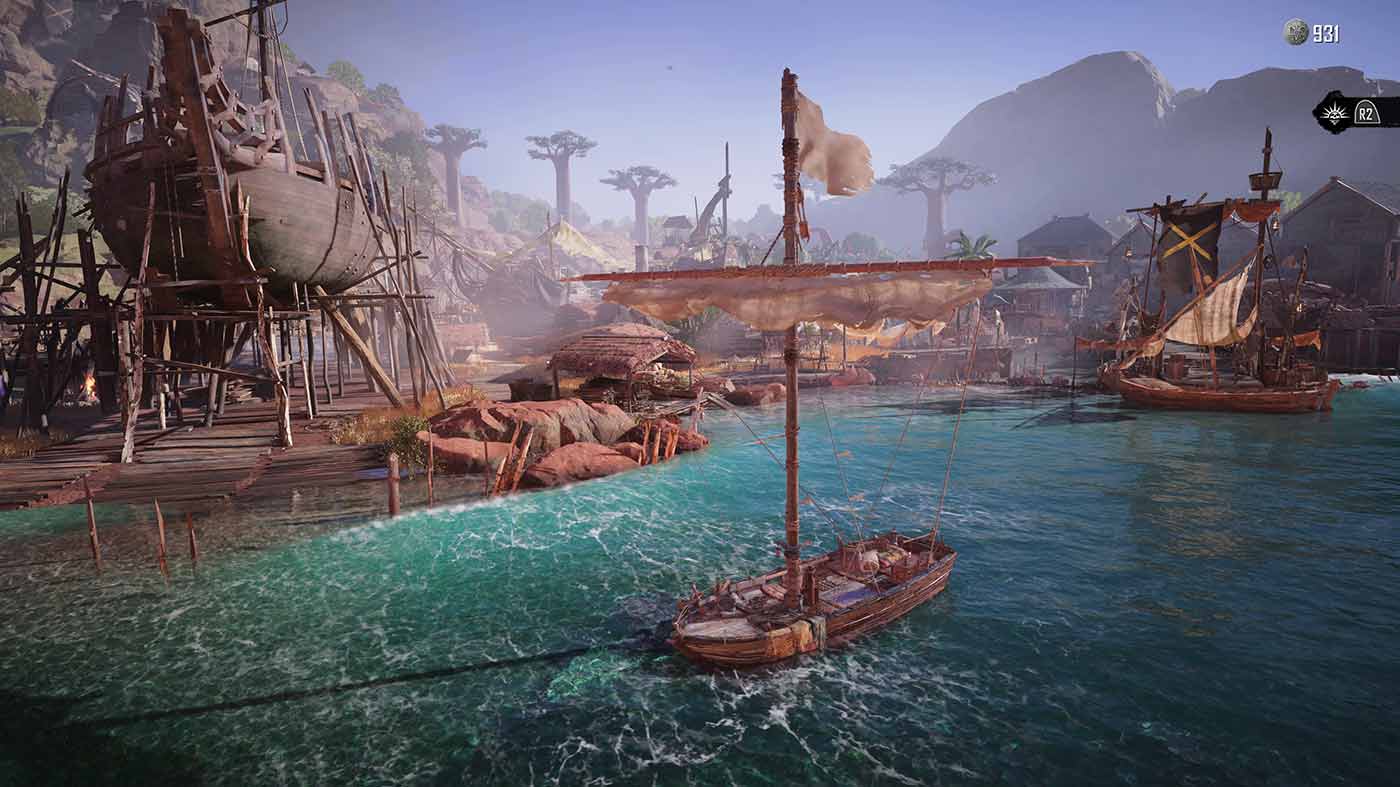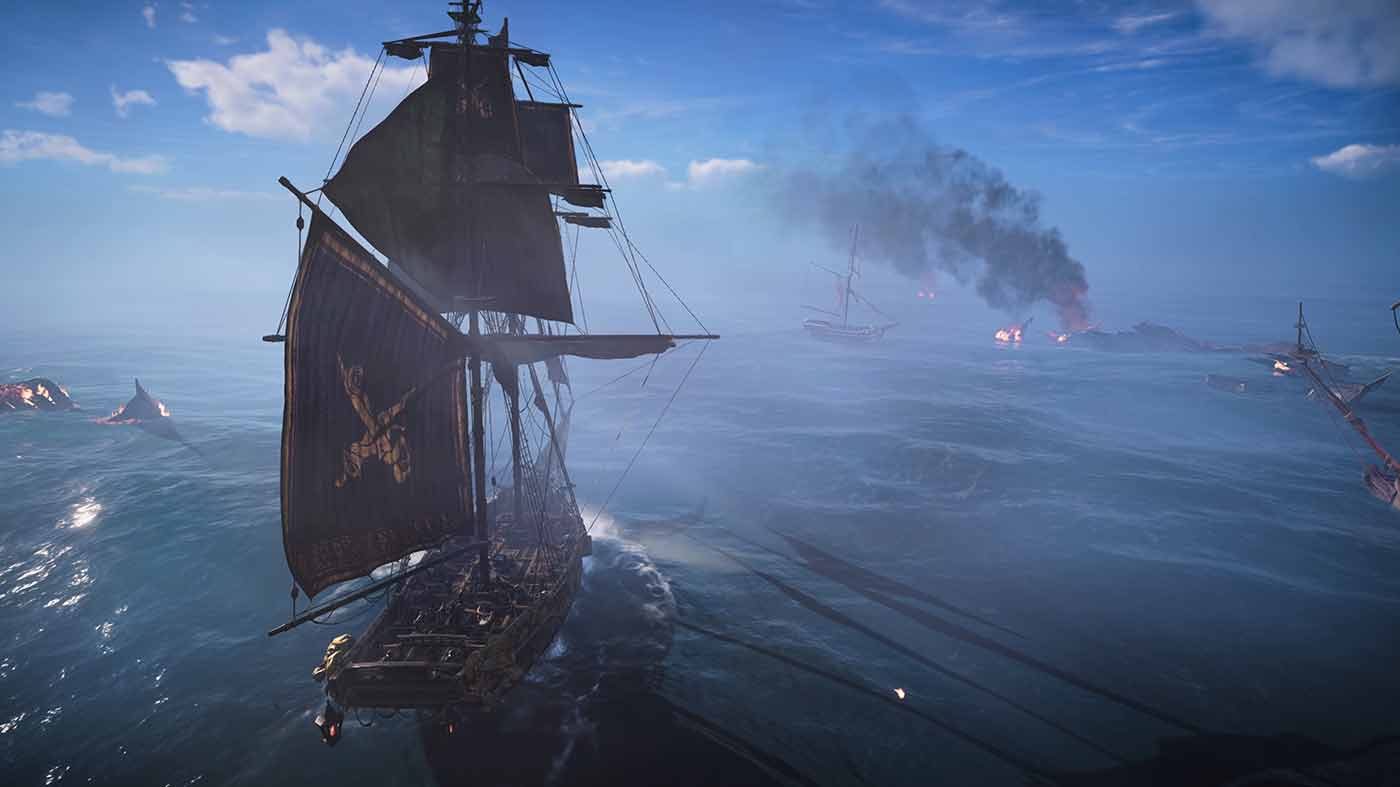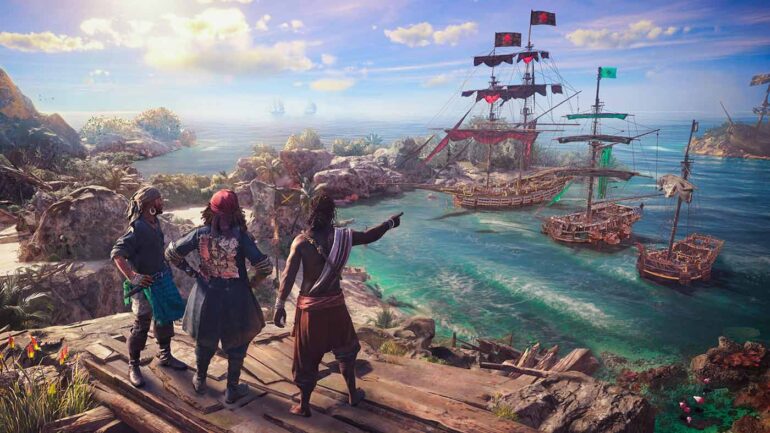Skull and Bones is a lean game. The byproduct of the game’s prolonged development cycle is perhaps an inadvertent response to what many consider to be the Ubisoft house style. In its years of production, and much to the chagrin of some expectant players, Skull and Bones has seemingly shed many of its skins, emerging as a streamlined and remarkably focused experience, at least in its early hours. This is a double-edged cutlass of course; with a stronger emphasis on a handful of systems, the game is quick on its feet with a palatable scope, but without the staple Ubisoft checklists, it leaves little room for error or even variety. Skull and Bones is a naval combat game, and that’s either enough for you or it isn’t.
Fortunately, there’s an innate satisfaction to navigating Skull and Bones’ waters. This isn’t hugely surprising—Skull and Bones only exists because ten years ago Ubisoft Montreal nailed it so hard in Assassin’s Creed IV: Black Flag, proving its sailing so popular that it fundamentally shifted the franchise and spawned work on DLC that would (eventually) grow into the game before us today. A decade of refinement is a luxury in this industry, and while the tone around Skull and Bones has been intermittently shifting between sour and curious, the time given to its systems has been very kind. I cannot begin to explain how much I enjoyed simply existing on these boats. The grander trappings of Skull and Bones aside, the baseline act of taking to the open sea is some pure, unadulterated good shit.

Skull and Bones casts you as a fully customisable shipwrecked scoundrel with a hungry eye trained on the upper echelons of pirate society, an unofficial ruling class of Kingpins whose crowns you covet and thrones you wish to topple. In a move that immediately differentiates the game from contemporary pirate stories, Skull and Bones sets this tale of rags to riches against a distinctly Southeast Asian setting, the Indian Ocean, allowing the game to pull on a visually and culturally diverse history. Ubisoft Singapore has crafted a romanticised world here, respectfully interweaving elements of the region’s pirate heritage and landmarks with exaggerated sea creatures, ghostly vessels, and elusive warring factions with whom your role can change based on your choices.
The core loop of Skull and Bones sees you running short missions out of the Sainte-Anne central hub, where you can customise your ship and cosmetics, trade with vendors, pick up quests and bounties, and follow the game’s main plot line. There doesn’t seem to be a wrong way to play as such, though the core story of pirate Kingpin John Scurlock’s quest to use you as a pawn against the local Sea People and their queen will fast-track your progress and exposure to the world.

Sainte-Anne cuts an impressive profile for the game’s introduction, a densely populated and decorated shanty town that immediately displays a grasp on environmental design and graphical fidelity beyond what previous hardware generations could likely have handled. You can practically smell this place, the sense of space and location is more akin to Red Dead Redemption 2 than most Assassin’s Creed titles. As you roam its streets, NPCs will heckle you or cheer you on depending on your rank, the game’s voice acting and general performances feeling a cut above what has come before in Ubisoft titles, though exactly how much that matters in the face of a grand open ocean and co-op pirating remains to be seen. That said, a random shopkeep told me he “wouldn’t give me the steam off his piss” and I laughed out loud sincerely for the first time in a Ubi game in a long while.
PRE-ORDER AT AMAZON FOR $89 WITH FREE SHIPPING.
Our preview session saw us helm two different ships, though most of the time was spent with the game’s second boat, the Bedar, a medium-sized skipper meant for captains still a little green around the gills. There’s a finesse to controlling these ships that is difficult to convey until you’ve gotten hands on with them, a perfectly tuned balance of arcade-y realism that encourages you to catch the wind and mind your port side but doesn’t punish more extravagant moves like drifting a whole-arse boat around enemy ships and tight corners. While sailing you can adjust your speed between three different sail modes, the highest allowing for faster navigation but at the cost of your crew’s stamina. Rapidly dropping speed allows for some very fun, very goofy manoeuvring, but for the most part you’ll need to be mindful of your ships pressure points and limits.

Moment to moment sailing is divided between two contrasting modes of engagement, combat and exploration. Open sea warfare is tense and challenging, your roaming vessel’s customisable weapon loadout and armour coming into play immediately as you often find yourself outgunned and numbered. While it’s tempting to just hoist the flag and sail right into danger, the game rewards a modicum of patience, allowing you to perch high up in the crow’s nest and use a spyglass to scope enemy weaponry and threat level before engaging. But prepared or not, the thick of it feels fantastic. Be it aligning shots with consideration for gravity drop and waves, targeting weakened ship parts, or eventually launching swift boarding crews for more loot, it all just clicks the way you would want it to.
Elsewhere, Skull and Bones takes on an entirely different, surprisingly welcome vibe. Switching to a first-person camera, you can take in the full spectacle of navigating the sizeable map as you watch waves crash and break on your deck, your chosen pet play beside you, crew exchange tasks and gags, and just generally absorb the beauty of what Ubisoft Singapore has crafted. It is deeply immersive, with the swaying of the ship being at times meditative and at others bloody terrifying. One instance saw me get lost in a small collection of snaking rivers, having to gingerly move our hulking ship through sharp turns as local wildlife ran along the shoreline. Another saw us hopelessly lost in a raging storm, the waves throwing the boat around with such force we took visible damage and had to chart a course to a nearby island until it passed. You can skip all of this, fast travel being available almost from the jump, but to do so would be to deny the idealised core experience of Skull and Bones and that would be a shame.

Often, Skull and Bones will invite you to head back to dry land and explore small, but richly lush, on-foot environments in search of treasure, allies, and quest items. Given the game’s initial design influences, it’s interesting to see just how far from combat these land segments place the player, not a swash to buckle in sight. Instead, these instances are borderline serene, leaning all the way into quiet, explorative vibes as your pirate pulls out a torch and ventures through overgrown forestry, musty caves, and places of worship for local cultures. The game is good at giving you reasons to be there, dolling out crudely drawn treasure maps to follow or highlighting a local NPC or settlement that you need to have a chin wag with. But there is a tangible lack of tension here too, each location I saw housed the same utilities and lacked the kind of risk/reward you’d expect to encounter on the open seas.
Underpinning all of this is Skull and Bones’ streamlined RPG systems, an amalgamation of Ubisoft-isms that are undemanding and largely inoffensive. Progression is tied to your Infamy, a pirate-themed levelling system that progressively unlocks new ships, items and cosmetics, each major rank housing smaller intervals of unlocks to keep the flow of rewards steady. To upgrade your ship, or do much of anything, you’ll need resources that can be gathered and plundered from your time at sea or as rewards for quests. The former involves an odd little quick time minigame that sees you pull your ship up to your desired resource, a tree or a shipwreck let’s say, and tap a button as a small meter moves between yellow and green segments. Hit the green, get a better pull, hit the yellow, and still get some wood but just a little less. It’s textbook Fine gameplay, though of all of Skull and Bones’ streamlining, it is easily its least interesting.

And while there is much to enjoy on your own in the game, Skull and Bones truly comes alive in co-op. Ubisoft Singapore hasn’t been shy about this, the majority of the game’s marketing having pivoted the experience to a live-service one that will rely heavily on player investment via seasonal content and roadmaps, but having faced company ships and harsh waters with a crew, it’s hard not to see why. The frenetic chaos of ship combat doubles its thrills with a friend, introducing another element to keep track of as your two ships gracefully skim the outskirts of an encounter, or clumsily collide mid-hunt. Quests and content have been designed with this in mind, both players sharing the progression and plunder, and given how deep the cosmetic system and ship customisation runs, I’m genuinely keen to see what my sicko mates do to their ships.
Despite how focused an experience Skull and Bones has turned out to be, it’s almost impossible to cover it all in a single preview. The crew’s sea shanties, the great inventory management, the overwhelming initial combat encounters, the weirdly non-committal politics of the world, the sheer scope of customisation – there’s a lot in here and almost all of it points toward a game I will enjoy, but for how long exactly I’m still unsure. Live service is a fickle, crowded market, and Skull and Bones’, well, bones, have a great deal of weight to bear if they’re to chart those waters. But if I ignore the market, forget the stats and systems, and just take to the sea with a nicely decorated boat and a vague sense of direction, that’s when it becomes a pirate’s life for me.
Skull and Bones launches on February 16th for PS5, Xbox Series X|S and PC. Amazon has pre-orders available for $89 with free shipping.



